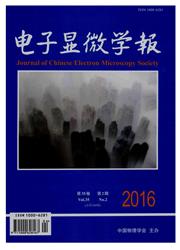

 中文摘要:
中文摘要:
采用Nicolet550型傅里叶变换红外光谱仪,对不同世代水热法合成KTP晶体的不同晶面进行了镜反射法红外光谱测试,与助熔剂法合成KTP晶体的红外光谱测试结果进行了比较,并估算了不同世代样品中羟基的浓度。测试主要针对水热法合成KTP晶体比较发育的(100)、(011)和(201)晶面,分基频区和指纹区两个区段进行。研究结果表明,水热法合成KTP晶体中OH^-的伸缩振动存在明显的方向性特征,其中[100]方向吸收明显,并且其频率比助熔剂法合成KTP提高约30cm^-1。样品中的羟基浓度依世代逐代下降,羟基的存在抑制了KTP晶体的生长,提高原料纯度对于提高晶体质量有重要意义。
 英文摘要:
英文摘要:
In the present paper, different-generation hydrothermally grown KTP crystals were tested by the Nicolet 550 type FIR spectrometer with the reflective technique. They were studied on different crystal faces. Since the hydrothermally grown KTP crystal usually grows (100), (011) and (201) crystal faces, these faces were tested in different-generation products, and they were tested by two spectral wave bands, 2 000-4 000 and 400-2 000 cm^-1. The figures were compared with the flux-melt grown KTP crystal. In addition, making reference to the method of calculation about the consistence of OH^-in quartz, the consistence of OH^-in different -generation hydrothermally grown KTP crystals was estimated. In the hydrothermal grown KTP crystals, the stretching vibration of OH^-shows distinct directivity characteristic. The absorption at [100] direction is obvious and the frequency is about 30 cm^-1 higher than the flux-melt grown KTP. Each new generation weakened the consistency of OH^-, which restrained the growth of the KTP crystal. Accordingly, increasing the purity of rough materials plays a very important role in improving the quality of the crystals.
 同期刊论文项目
同期刊论文项目
 同项目期刊论文
同项目期刊论文
 Submicron-sized fluid inclusions and distribution of hydrous components in jadeite, quartz and sympl
Submicron-sized fluid inclusions and distribution of hydrous components in jadeite, quartz and sympl Defect Microstructures in Garnet, Omphacite and Symplectite from UHP Eclogites, Eastern Dabieshan, C
Defect Microstructures in Garnet, Omphacite and Symplectite from UHP Eclogites, Eastern Dabieshan, C 期刊信息
期刊信息
